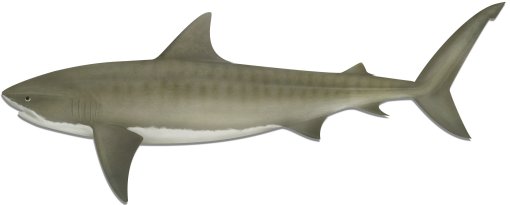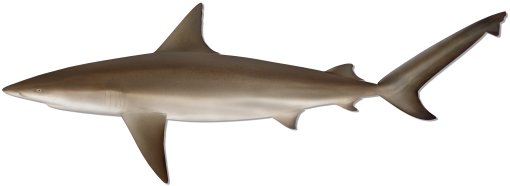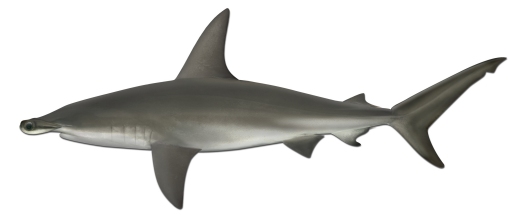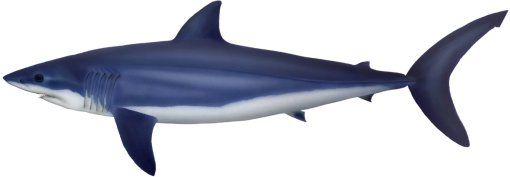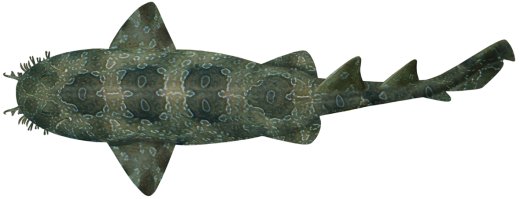Sharks are a natural part of healthy oceanic and estuarine environments. When people enter open water, they are entering the shark's domain.
The word 'shark' is used to describe a broad range of aquatic creatures, but not all sharks are dangerous to humans. Nearly all shark bites in coastal waters are attributed to just three species: White sharks (also known as great white sharks and white pointers), bull sharks and tiger sharks.

Here are the most common questions we receive on white sharks:
White sharks are found near shore along most of the world's temperate coastlines but are relatively scarce compared to most other widely distributed shark species. In Australia, white sharks have been recorded from central Queensland, around the southern coast to North West Cape, Western Australia, but are more common in the south.
White shark movements show a pattern of long distance travel in between spending short periods of time at favoured locations. There is no such thing as a resident white shark.
Check out the Shark Activity page to see where DPI-tagged white sharks have travelled.
Our CSIRO colleagues have developed a world-first genetic analysis technique to estimate adult white shark numbers for both the eastern Australasian and southern-western white shark populations.
CSIRO research reveals that there are about 750 adults in the eastern Australasian white shark population (with a range from 470 to 1,030), with a total eastern population of 5,460 (with a potential range between 2,909 and 12,802). For the southern-western population, the estimate is 1,460 adult white sharks (with a range of 760 to 2,250).
White sharks are internationally protected by many nations and listed under the Convention on International Trade in Endangered Species and the Convention on the Conservation of Migratory Species (PDF, 541 KB), to which Australia is a signatory. White sharks are currently listed as ‘Vulnerable’. The biology of white sharks means their populations are vulnerable and slow to recover once depleted.
White sharks are slow growing and reproduce around 16 years of age when they are approximately 5 metres in length. From what we know, females give birth to around 10 sharks, known as pups, and they don’t reproduce every year.
Shark identification
Target Sharks
White, bull and tiger sharks are referred to as ‘target sharks’ as they are the three sharks that are most frequently involved in serious shark bites in NSW and are the focus of the NSW Government’s tagging and tracking and shark mitigation programs.
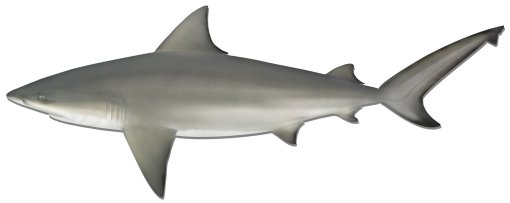
Alternative names: Swan River whaler, freshwater whaler.
Scientific name: Carcharhinus leucas
Diet: Bull sharks will eat almost anything including fish, other sharks and rays, turtles, birds, molluscs, crustaceans and dolphins.
Size: Adults can range from 2 to 3.5 metres in length and up to 230kg in weight.
Range: The bull shark is found along coastlines in tropical and subtropical oceans, which in Australia occurs from the central NSW coast, across the northern coast to Perth, Western Australia. It is the only widely distributed shark that penetrates far into fresh water for extended periods where it sometimes breeds.
Interesting facts:
- Females normally give birth in estuaries and river mouths and the young can remain in the river for up to five years.
- It is a dangerous shark due to its aggressive nature, powerful jaws, broad diet, abundance and its habitat preference of shallow, murky inshore waters.
Identifying the Bull Shark:
- It has a short snout that is wider than it is long, hence the name.
- The teeth are triangular, saw-edged and very sharp.
- The belly is usually off-white, the top surface grey and the eyes are small.
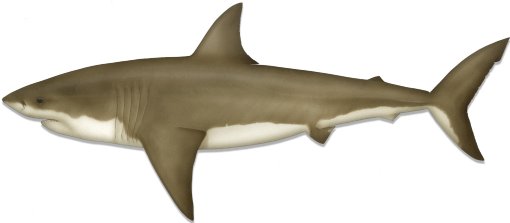
Alternative names: white pointer, great white shark.
Scientific name: Carcharodon carcharias
Diet: The diet of young white sharks (under about 3.5 metres) is mainly a variety of fish, rays and other sharks. Larger adults eat larger prey including marine mammals, such as sea lions, seals and small-toothed whales. They also eat dead animals floating in the water.
Size: The biggest recorded specimen was 7 metres long and 3,200kg.
Range: White sharks are found near shore along most of the world's temperate coastlines but are relatively scarce compared to most other widely distributed shark species. In Australia, white sharks have been recorded from central Queensland, around the southern coast to North West Cape, Western Australia; however, are more common in the south.
Interesting facts:
- White sharks are listed as a vulnerable species in many Australian states, including NSW, and also in several other countries.
- White sharks have a heat-exchanging circulatory system that keeps their body warmer than the surrounding water.
Identifying the white shark:
- Only the underbelly is white: the top surface is grey to blue/grey or bronzy.
- The teeth are large, serrated and triangular.
Scientific name: Galeocerdo cuvier
Diet: It is one of the few sharks that is a true opportunistic scavenger, taking a wide range of prey including fish, turtles, crabs, clams, mammals, sea birds, reptiles, other sharks and just about anything else they can catch alive, as well as a variety of inanimate flotsam items.
Size: It can grow to around 6 metres but on average are about 3 metres.
Range: Tiger sharks are found worldwide in warm tropical and subtropical seas where they inhabit both shorelines and open waters. They occur across northern Australia and as far south southern NSW and Perth in Western Australia.
Interesting facts:
- Its occurrence in shallow water, indiscriminate diet and large size make it one of the most dangerous and aggressive sharks.
- Tiger and bull sharks are both large whaler sharks and are related to dusky and bronze whaler sharks.
Identifying the tiger shark:
- The species has tiger-like, striped markings on a dark, grey-brown back with off-white underbelly.
- The teeth are heavily saw-edged, cockscomb shaped, razor-sharp, and the same in both upper and lower jaws.
Other sharks of NSW inshore waters
Alternative names: narrowtooth or copper shark.
Scientific name: Carcharhinus brachyurus
Diet: They prey on squid and bottom-dwelling fish and also feed on schooling fish such as salmon.
Size: They are large, up to 3.5 metres and 300kg.
Range: Bronze whalers inhabit many temperate seas and oceans around the world. They are often seen close inshore feeding on schooling fish such as salmon, but are also found near deep water. The bronze whaler occurs throughout southern Australia from Jurien Bay (WA) to about Coffs Harbour, NSW.
Interesting facts:
- Potentially aggressive sharks that have attacked people and can be dangerous to spearfishers with fresh catches as well as surfers, as their natural prey is often found in the surf zone.
Identifying the bronze whaler:
- Colour is grey to bronze on the back and white below.
- The pelvic and pectoral fins can have dusky to black tips.
Alternative names: sand tiger shark, spotted-ragged tooth shark.
Scientific name: Carcharias taurus
Diet: They shelter in caves or gutters during the day and emerge to feed at night on bony fishes such as mackerels, other sharks and rays, squids, crabs and lobsters.
Size: Greynurse sharks can grow to at least 3.2 metres in length.
Range: They are a large shark native to subtropical to cool temperate waters in the Mediterranean Sea and the Atlantic, Indian and western Pacific Oceans. Once widely distributed, they are now mainly restricted to Australia and the east coasts of the USA, Uruguay, Argentina and South Africa. In Australia, there is an east coast and a west coast population. The east coast population is found predominantly in inshore coastal waters along the coast of NSW and southern Queensland. There are a number of key habitat sites along the coast of NSW and southern Queensland where they are regularly found in groups. These sites generally have sandy-bottomed gutters or rocky caves and are in the vicinity of inshore rocky reefs or islands.
Interesting facts:
- Greynurse sharks are listed as a critically endangered species in NSW.
- During pregnancy, the more fully developed embryos eat the less developed embryos and unfertilised eggs within the female shark’s uterus. As a result, only two pups are produced per litter. Greynurse sharks tend to breed only once every two years.
Identifying the greynurse shark:
- Greynurse sharks have large, stout bodies tapered at both ends, a pointed snout and small eyes. They have two large top (or dorsal) fins of similar size.
- The upper surface of greynurse sharks is bronze coloured and the underside is paler.
- Juveniles often have dark spots on the lower half of the body and the caudal fin. These spots fade as the shark becomes larger, but are sometimes still seen on adults.
Scientific name: Sphyrna zygaena (Smooth Hammerhead)
Diet: A migratory predator with a good sense of smell, it eats fish, squid, octopus, crustaceans and, in particular, stingrays.
Size: Hammerheads range from under 1 metre, up to the great hammerhead (Sphyrna mokarran) averaging 3.5 metres, but with a largest reported size of 6 metres and 450kg.
Range: In Australia, smooth hammerheads occur south from Coffs Harbour to around Jurien Bay, Western Australia, and are the most common of the hammerheads in NSW. Females are thought to give birth in nearshore waters of the NSW coast between January and March, when they are often observed in large schools swimming just outside the surf zone of NSW beaches.
The scalloped hammerhead is recorded throughout the north from Sydney NSW to Geographe Bay in Western Australia. The great hammerhead prefers tropical and warm temperate seas and occurs north from Sydney NSW to the Abrolhos Islands off Western Australia.
Interesting facts:
- The mouth of the hammerhead is located on the underside of the head.
- It is well known for its ability to make sudden and sharp turns.
- There are nine species of hammerhead sharks, three of which are known to occur in NSW waters: the smooth hammerhead, scalloped hammerhead and great hammerheads.
- The scalloped and great hammerheads are listed as endangered and vulnerable species, respectively, in NSW.
Identifying the hammerhead shark:
- Great hammerheads have a wide, thick head with eyes at the margins of the hammer which is almost rectangular in shape.
- It is greyish brown above and off-white below, and is found in temperate to tropical waters worldwide along coastlines, the continental shelf and adjacent drop-offs to about 80 metres.
Alternative names: Blue-pointer shark, bonito shark, mackerel shark, black-winged shark.
Scientific name: Shortfin mako is known as Isurus oxyrinchus and its longfin cousin is the Isurus paucus.
Diet: Prey is mainly bony fish as well as other sharks, sea turtles, herons, dolphins and possibly scavenged long-lined and netted fish.
Size: Reaches around 3.2 metres and 400 kg.
Range: Shortfin mako are found in offshore temperate and tropical waters to depths of 150 metres. It occurs along the entire NSW coast and is widespread in most of Australia's coastal shelf and ocean waters.
Interesting facts:
- Makos are renowned for their ability to leap out of the water. There have been recorded cases of angry makos jumping into boats after being hooked.
- Mako sharks are in the same family as white shark and porbeagle shark.
Identifying the Mako:
- Colour is bluish black with a white underside and a hydrodynamic shape, which provides spectacular speed and agility.
Alternative names: The name is believed to be of Aboriginal origin meaning 'shaggy beard' after skin flaps around the mouth.
Scientific name: ornate wobbegong (Orectolobus ornatus), spotted wobbegong (Orectolobus maculatus), banded wobbegong (O. halei).
Diet: Includes lobsters, crabs, octopuses and bony fish.
Size: The largest species, the spotted wobbegong, can grow to 3.2 metres in length, although it seldom exceeds 160cm in NSW.
Range: At least eight species of wobbegongs are known in Australian waters, with three found along the NSW coast. The ornate wobbegong (Orectolobus ornatus) is distributed from Port Douglas in North Queensland to Sydney in the south. The spotted wobbegong (Orectolobus maculatus) is also found along Australia's east coast from about Gladstone on Queensland's central coast, down to southern Australia and across to Western Australia. The third NSW wobbegong is the banded wobbegong (O. halei), which ranges around the south of the continent from southern Queensland to southern Western Australia.
Interesting facts:
- Wobbegongs, like most other sharks, are not dangerous unless provoked.
- They have bitten divers who poked or hindered them and people who accidentally trod on them in shallow water. Their long, slender, dagger-like teeth can penetrate a wetsuit, and when they bite, they may hang on and be very difficult to remove.
Identifying the wobbegong:
- Well camouflaged with bold, symmetrical, carpet-like markings.



